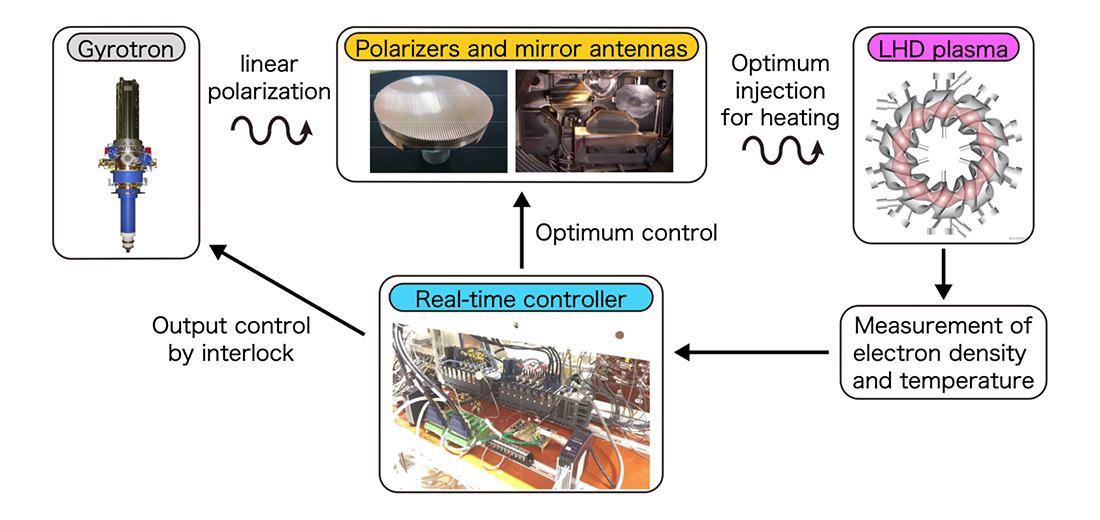Real-time control of millimeter-wave propagation for highly efficient plasma heating
We have developed a real-time control system for the millimeter-wave injection system for electron cyclotron heating and have shown that the system can heat the plasma efficiently by optimizing the injection for the time-varying plasma in LHD. We have also succeeded in improving high electron-temperature operations and high-density operations by using this control system. This achievement will contribute to the sustainment of high-efficiency heating during high-power and long-pulse operations and improve the accuracy of transport studies to evaluate the performance of fusion plasmas.

We have developed a real-time control system for the millimeter-wave injection system for electron cyclotron heating and have shown that the system can heat the plasma efficiently by optimizing the injection for the time-varying plasma in the Large Helical Device (LHD). We have also succeeded in improving high electron-temperature operations and high-density operations by using this control system. This achievement will contribute to the sustainment of high-efficiency heating during high-power and long-pulse operations and improve the accuracy of transport studies to evaluate the performance of fusion plasmas.
In fusion power generation, external heating input is required to ignite the plasma and control the plasma stability. Electron cyclotron (EC) heating is one of the promising external heating methods for future fusion reactors. It is also effective in preventing damage to the components in the vacuum vessel due to stray waves that are not absorbed inside the vacuum vessel. High efficiency is also essential for high-precision analysis in transport studies to evaluate plasma confinement performance.
This study has developed a real-time control system for the millimeter-wave injection system for EC heating using a rewritable digital circuit called FPGA. The millimeter-wave propagation is calculated according to the time-varying electron density and temperature profiles of the LHD plasma, enabling efficient heating. The effect of refraction bends millimeter waves propagating in the plasma. The higher the electron density and the larger the density gradient, the easier it is to bend.
In this research, the angle of the mirror antenna in the millimeter-wave injection system was controlled by rotation to heat the center of the plasma as much as possible. The angle of the polarizer of the millimeter-wave injection system was also rotated to control the polarization (direction of the oscillating electric field of the millimeter-wave) for better heating. As a result, it was shown that highly efficient heating could be maintained even in a high-density region compared to a case without control.
It has been difficult to perform perpendicular injection, which is a method of injection that is inherently difficult to bend, due to the complexity of the three-dimensional magnetic field configuration and the accompanying structure of the inner wall of the vacuum vessel. Using the control system developed in this study, we have implemented an interlock that allows high-power millimeter-wave injection only when sufficient absorption is expected in the plasma. With this improvement, we have succeeded in enhancing the performance of high electron temperature and high-density operation of LHD plasmas, contributing to expanding the plasma parameter range for physics experiments such as transport research.
In the future, we plan to build a more sophisticated AI control system by using deep learning and more detailed profile information on plasma parameters. In addition to the EC heating control, establishing the operation control method for fusion power generation is one of the critical issues to be addressed. We will continue to develop it further by incorporating the latest technologies outside the field of fusion science.
This research was carried out in collaboration with a research group led by Assistant Professor Toru Tsujimura at the National Institute for Fusion Science and Assistant Professor Shinsuke Ohshima at the Institute of Advanced Energy, Kyoto University.
The results of the development of the millimeter-wave injection control system for EC heating and the demonstration of high-efficiency heating were published on January 23, 2020 in Fusion Engineering and Design, an international journal on fusion energy and technology. The results of using the control system to improve LHD plasma performance by perpendicular injection were published in Nuclear Fusion, a journal on controlled thermonuclear fusion by the International Atomic Energy Agency, on December 22, 2020. The results were presented at the 28th IAEA Fusion Energy Conference held from May 10 to May 15, 2021.
Publication
- T. Ii Tsujimura et al., "Real-time control of the deposition location of ECRH in the LHD", Fusion Engineering and Design 153 (2020) 111480. [NIFS Repository]
- T. Ii Tsujimura et al., "Improved performance of electron cyclotron resonance heating by perpendicular injection in the Large Helical Device", Nuclear Fusion 61 (2021) 026012. [NIFS Repository]
